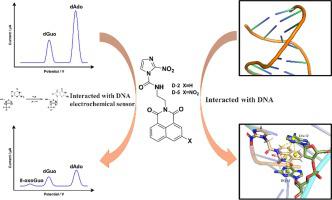当前位置:
X-MOL 学术
›
Microchem. J.
›
论文详情
Our official English website, www.x-mol.net, welcomes your
feedback! (Note: you will need to create a separate account there.)
Electrochemical detection of DNA damage caused by novel potential 2-nitroimidazole naphthalimide-based hypoxia tumor-targeting agent with mimimum side effects
Microchemical Journal ( IF 4.9 ) Pub Date : 2022-03-26 , DOI: 10.1016/j.microc.2022.107435
Dong Chen 1 , Xuan Yu 1 , Yue Qin 2 , Zi-Yang Liao 1 , Tong Li 1 , Fei-Fei Guo 1 , Kai-Xin Song 1 , Ri-Lei Yu 3 , Ya-Mu Xia 1 , Wei-Wei Gao 1
Microchemical Journal ( IF 4.9 ) Pub Date : 2022-03-26 , DOI: 10.1016/j.microc.2022.107435
Dong Chen 1 , Xuan Yu 1 , Yue Qin 2 , Zi-Yang Liao 1 , Tong Li 1 , Fei-Fei Guo 1 , Kai-Xin Song 1 , Ri-Lei Yu 3 , Ya-Mu Xia 1 , Wei-Wei Gao 1
Affiliation

|
In this work, we designed and synthesized two novel 2-nitroimidazole-naphthalimide-derived antitumor agents N -(2-(naphthalimide)ethyl)-2-(2-nitroimidazole)acetamide (D-2 ) and N -(2-(5-nitro-naphthalimide)ethyl)-2-(2-nitroimidazole)acetamide (D-5 ). The oxidative damage induced by the interaction between D-2 (D-5 ) and DNA was investigated by CV and DPV. The efficient electrochemical biosensors were prepared through modifying GCE with calf thymus DNA, poly dA and poly dG, respectively. The redox mechanism of D-2 (D-5 ) on GCE surface involved the reduction of 2-nitro group on imidazole ring and the oxidation of methylene linked naphthalimide skeleton and 2-nitroimidazole. The results of voltametric evaluation of interaction between antitumor agent and DNA/GCE revealed the oxidative damage of DNA caused by D-2 (D-5 ). In addition, UV–vis absorption and fluorescence spectra were investigated to further distinguish the interaction mode between D-2 (D-5 ) and DNA, implying the intercalation mode of D-2 (D-5 ) toward base pairs of DNA with a high affinity. At last, D-2 and D-5 were proved to have significantly better cell selectivity than mitonafide, the fact indicated that D-2 and D-5 had the potential for becoming lead antitumor agents and eliminating the side effects toward normal cells.
中文翻译:

电化学检测由新型电位 2-硝基咪唑萘苯二酰亚胺基缺氧肿瘤靶向剂引起的 DNA 损伤,具有最小的副作用
在这项工作中,我们设计合成了两种新型的 2-硝基咪唑-萘酰亚胺衍生的抗肿瘤剂 N-(2-(萘酰亚胺)乙基)-2-(2-硝基咪唑)乙酰胺 (D-2) 和 N-(2-(5-硝基-萘酰亚胺)乙基)-2-(2-硝基咪唑)乙酰胺 (D-5)。通过 CV 和 DPV 研究 D-2 (D-5) 与 DNA 相互作用诱导的氧化损伤。通过分别用小牛胸腺 DNA 、 poly dA 和 poly dG 修饰 GCE 制备高效的电化学生物传感器。GCE 表面 D-2 (D-5) 的氧化还原机制涉及咪唑环上 2-硝基的还原以及亚甲基连接的萘酰亚胺骨架和 2-硝基咪唑的氧化。抗肿瘤药物与 DNA/GCE 之间相互作用的伏涂评估结果显示 D-2 (D-5) 引起的 DNA 氧化损伤。此外,研究了紫外-可见吸收和荧光光谱,以进一步区分 D-2 (D-5) 和 DNA 之间的相互作用模式,这意味着 D-2 (D-5) 对具有高亲和力的 DNA 碱基对的嵌入模式。最后,D-2 和 D-5 被证明具有明显优于米托那非的细胞选择性,事实表明 D-2 和 D-5 有可能成为领先的抗肿瘤药物并消除对正常细胞的副作用。
更新日期:2022-03-26
中文翻译:

电化学检测由新型电位 2-硝基咪唑萘苯二酰亚胺基缺氧肿瘤靶向剂引起的 DNA 损伤,具有最小的副作用
在这项工作中,我们设计合成了两种新型的 2-硝基咪唑-萘酰亚胺衍生的抗肿瘤剂 N-(2-(萘酰亚胺)乙基)-2-(2-硝基咪唑)乙酰胺 (D-2) 和 N-(2-(5-硝基-萘酰亚胺)乙基)-2-(2-硝基咪唑)乙酰胺 (D-5)。通过 CV 和 DPV 研究 D-2 (D-5) 与 DNA 相互作用诱导的氧化损伤。通过分别用小牛胸腺 DNA 、 poly dA 和 poly dG 修饰 GCE 制备高效的电化学生物传感器。GCE 表面 D-2 (D-5) 的氧化还原机制涉及咪唑环上 2-硝基的还原以及亚甲基连接的萘酰亚胺骨架和 2-硝基咪唑的氧化。抗肿瘤药物与 DNA/GCE 之间相互作用的伏涂评估结果显示 D-2 (D-5) 引起的 DNA 氧化损伤。此外,研究了紫外-可见吸收和荧光光谱,以进一步区分 D-2 (D-5) 和 DNA 之间的相互作用模式,这意味着 D-2 (D-5) 对具有高亲和力的 DNA 碱基对的嵌入模式。最后,D-2 和 D-5 被证明具有明显优于米托那非的细胞选择性,事实表明 D-2 和 D-5 有可能成为领先的抗肿瘤药物并消除对正常细胞的副作用。

































 京公网安备 11010802027423号
京公网安备 11010802027423号